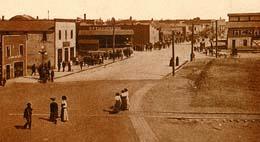In the early hours of August 14, 1895, father and son Sam and Charles Vinson are lynched in Ellensburg by a mob of 50 people. Although some call for prudence, a crowd of 150 stands by and watches.
The Vinsons were little liked in Ellensburg. Sam was an alcoholic who was known to abuse his wife, and Charles had served time in the territorial penitentiary for armed robbery. Both enjoyed picking fights and both carried guns.
On the evening of Sunday, August 11, 1895, Sam Vinson was panhandling for drinks in the Teutonia Saloon. He approached John Buerglin, who refused to buy him a drink, remarking that Vinson already owed him money. Sam Vinson grabbed a knife and sliced open Buerglin's abdomen. Buerglin fended Vinson off with a whiskey bottle and then, clutching his stomach, staggered to a doctor's office.
Charles Vinson, who had been drinking, panhandling, and hassling the manager in a nearby restaurant, entered the saloon just as his father stabbed Buerglin. As saloon patrons attempted to force Charles out, he drew his gun and shot bar owner Michael Kohlhepp in the chest. Patrons wrestled both father and son to the ground, handcuffed them together, and took them to the county jail. Michael Kohlhepp died a few hours later.
The next morning, a hastily impaneled coroner's jury concluded that Charles Vinson's shot had caused Michael Kohlhepp's death. Justice James Boyle ordered Vinson held for trial. He was charged with first-degree murder.
On Tuesday, August 13, John Buerglin died of infection resulting from his knife wound. Townspeople began to gather outside the jail. Both of the deceased men had been well-liked and respected. Sheriff William Stinson posted armed guards to protect the prisoners, as the crowd around the jail grew larger.
At 12:15 a.m. on August 14, following the sounding of two alarm bells, the armed crowd overtook the building. The mob broke down a wooden door, and then broke a padlock off an iron door. When the reinforced steel on the cell door proved challenging, the vigilantes used sledgehammers, chisels, and even a piece of railroad track to try and break into the cell. Within the cell Charles Vinson taunted the mob, fanning his hat to snuff the single candle which lit their efforts.
The mob ignored pleas for dispersion from clergymen and superior court judge Carrol B. Graves. After two hours of determined sawing at the hinges of the cell, the door gave way. The vigilantes threw ropes around the Vinsons' necks. They pushed the men roughly through the town, stopping repeatedly by trees and light poles as they searched for a gallows. Finally a cottonwood tree at the northwest corner of 7th and Pine proved sturdy enough for the task.
As they prepared to hoist the Vinsons to their deaths, the vigilantes offered their prisoners a chance to utter some final words. Sam Vinson cried out his disbelief and horror at what was to come. His son Charles begged the crowd to tell his mother that he loved her.
The lynching mob was 50 strong, and some 150 townspeople had gathered at the fringes to watch the executions. When questioned later, no one in the crowd was able to identify a single lyncher, although few masks had been worn that early August morning.
The bodies of Sam and Charles Vinson hung from the cottonwood until seven o'clock. They were then prepared for burial. Martha Vinson refused possession of the bodies of her son and husband. They were buried in unmarked graves in the Potter's Field next to the Holy Cross Catholic cemetery. Their burial expenses were paid by Kittitas County.
Lynching was unusual but not unheard of in Washington by 1895. Known as "rough justice" when it was meted out on the Western frontier, civilization and a codified justice system had by then rendered Western lynching a historical artifact, almost.

